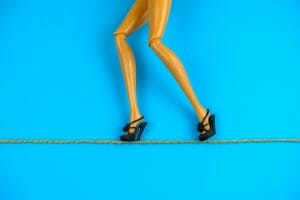How to Improve your Walking Technique for Better Balance and Healthy Joints

When a better walking technique is important
Lower Extremities – Legs
Walking - a balancing act

Look at what’s happening at your knees. For example, when walking, do they turn out, in, or can they move straight ahead?
The knee and ankle joint are structured as hinge joints and function best when facing forward. This design provides both functional as well as economic movement. Compare the way your legs move forward to that of a car’s tires and steering. If your tires are not correctly aligned, they’ll most surely begin to wear unevenly and eventually be replaced prematurely. The same can be said for the way we walk. Poor mechanics and movement patterns of the feet, legs, and hips may have a similar wearing effect. Sure, the body is tougher and more resilient than rubber tires, but a similar principle applies.
Become more aware of your FEET and how they move.
Do you land on your heel, allowing the feet to roll forward through to the toes, or do you slap your feet down flat, moving forward as if your feet are rigid boards that somehow propel you forward?
Take time to notice what your feet are doing. Then, slow down and feel for the softness in your feet as your heel gently and softly lands on the ground to initiate the ‘rocker’ like cycle of heel-to-toe walking.
- What are your knees doing?
- Do they go straight ahead, or
- Do they angle to the left or right as you walk?
Don't Force any Movement
Make sure you are not forcing your legs to track straight ahead. The human body allows us a little flexibility to move within a healthy range — working a ‘little’ from the ideal.
Suggestion: If any movement feels forced, then back off. When excessive ‘effort’ is needed, poor mechanics can impact overall joint health and wellbeing.
The moment that movement is forced and requires extensive muscular contraction to ‘create’ or generate a sought-after pattern of ‘organic’ movement, we have lost the goal of the desired action. If this occurs, back off until you find yourself moving at a comfortable speed and range, knowing that this is where you should be ‘right now’.
Understand that this will change and improve as you become more open and aware of the goals of each movement, sequence of actions, and functional goals of postural awareness.
Conflict at the KNEE
Too many variables exist at the knee for movement to be taken for granted.
Posture Geek

In its wisdom to keep us moving forward, our body creates an environment where movement from the ground up is geared towards this end – always striving to aim straight ahead. However, the means to this end are often not as crucial at an unconscious level as we would desire.
For example, the leg will frequently rotate internally as a natural pattern when a fallen arch occurs. However, in an attempt to provide balance and direction, the body will work out a way to bring movement back to forward momentum.
An example of the fascial implication of this can be seen in the Peroneus Longus muscle. This muscle helps lift the lateral (outside) arch of the foot. Therefore, excessive tightness in this muscle may lead towards an INCREASED EVERSION (turning out of the foot). This can lead to a DECREASED SUPPORT of the foot on the ankle.
The compensation that’s created from this issue can develop changes further up the kinetic chain. Imagine the impact of this if you were moving through a compound movement, such as a Squat?
This is where gait assessment becomes invaluable. By analyzing how these compensations affect walking patterns, gait assessment can identify misalignments and asymmetries in movement that may not be immediately apparent. This insight allows for targeted interventions that correct the underlying issues, ensuring that the body’s natural aim towards forward momentum is supported efficiently and healthily.
Get rid of any unnecessary tension in your arms, shoulders, or neck while walking.

Do not force the direction of movement. Instead, let your arms swing in an alternating pattern without restricting or exaggerating their movement. This will allow your hips and torso to move freely and without tension.
PLEASE NOTE
The information provided should not replace the advice and expertise of an accredited health care provider. Any inquiry into posture care and any potential impact on your health and wellbeing should be directed to your health care provider.

